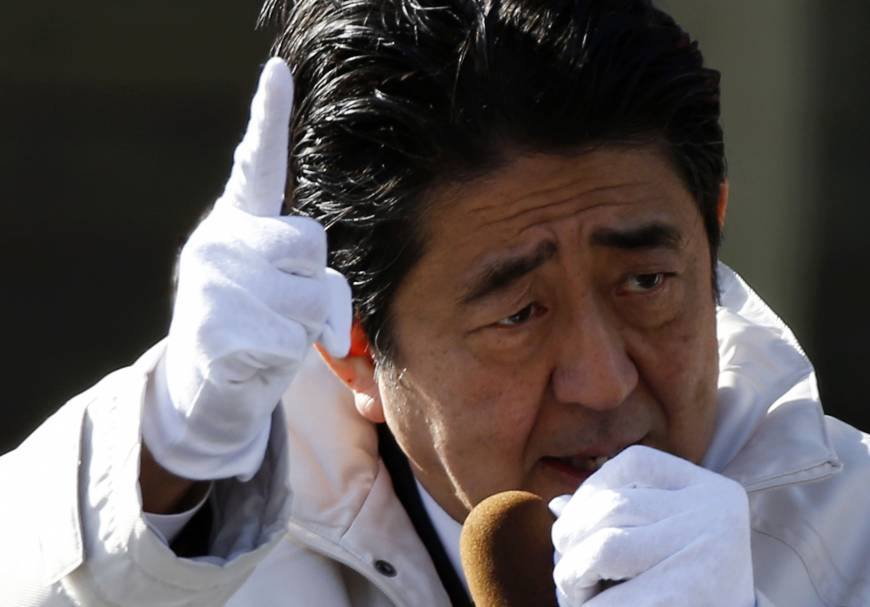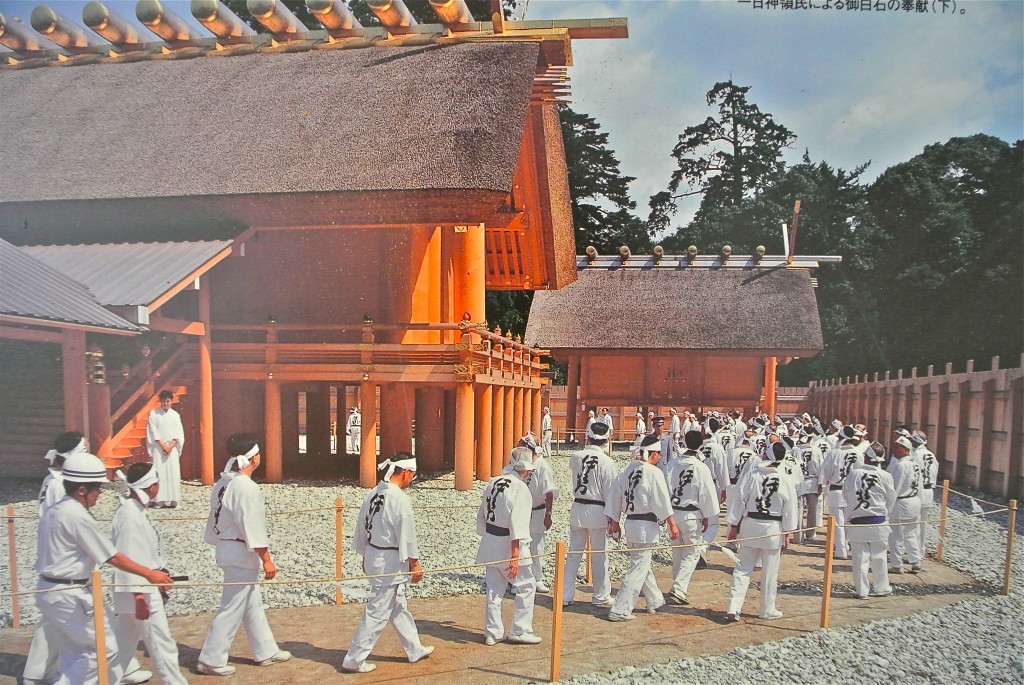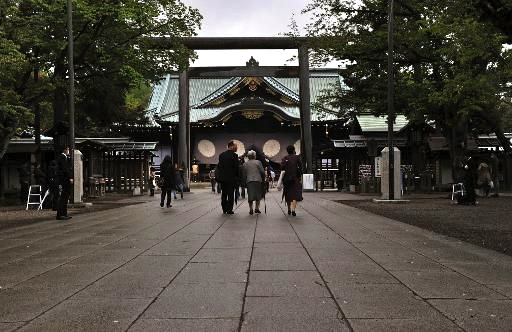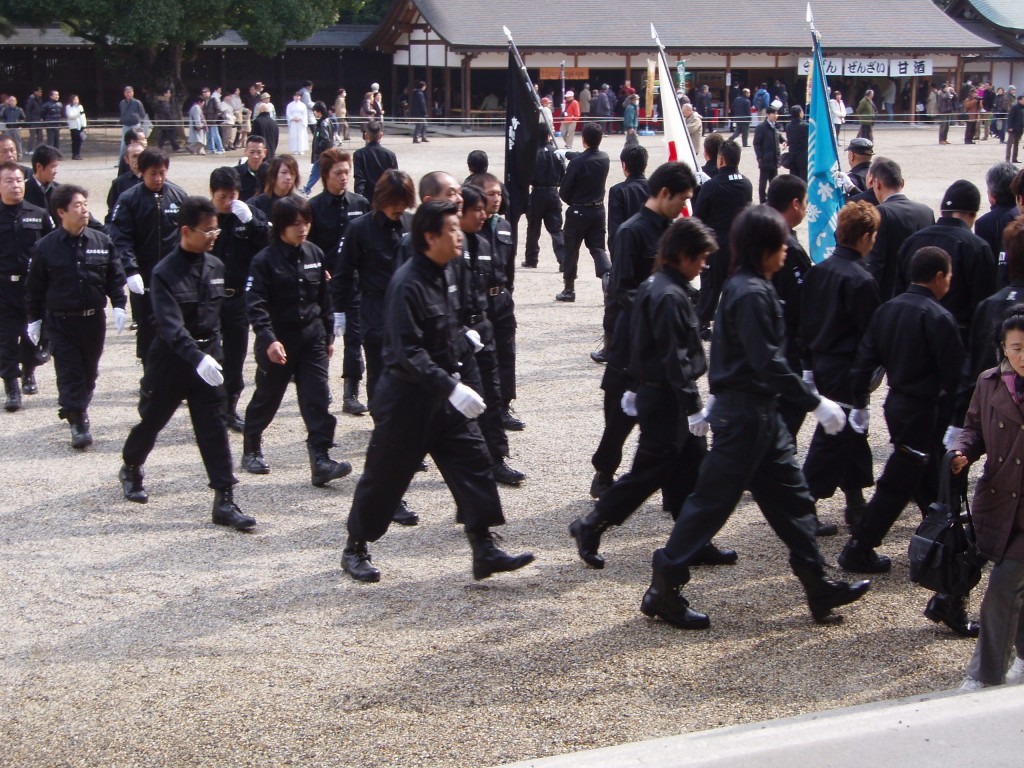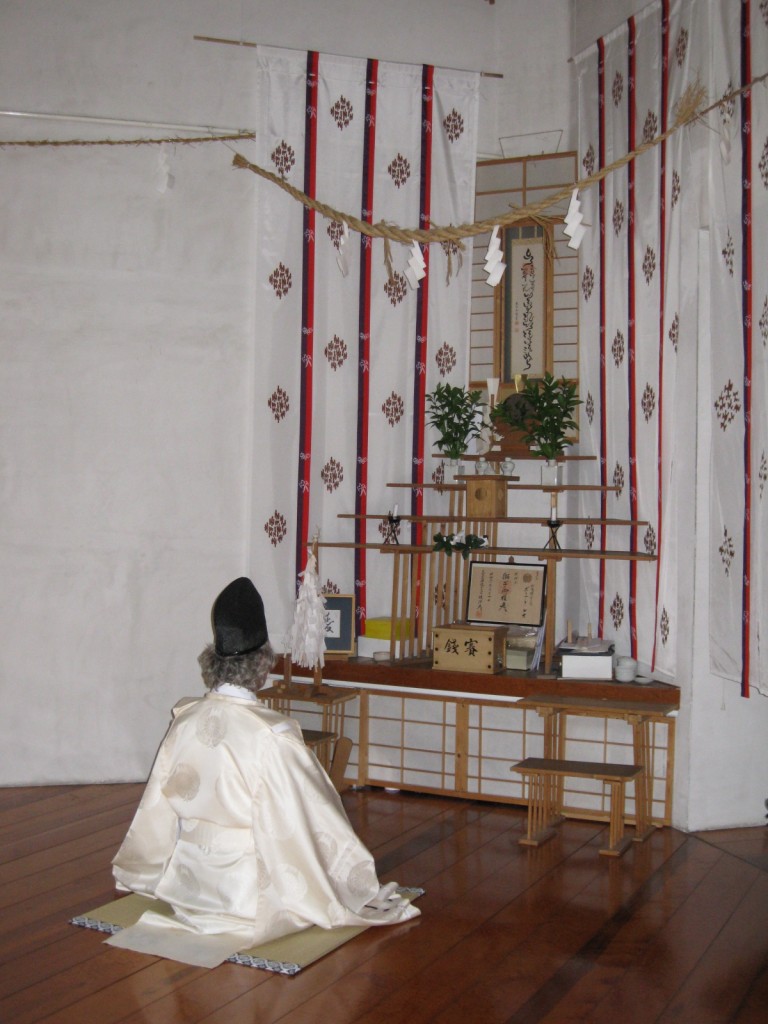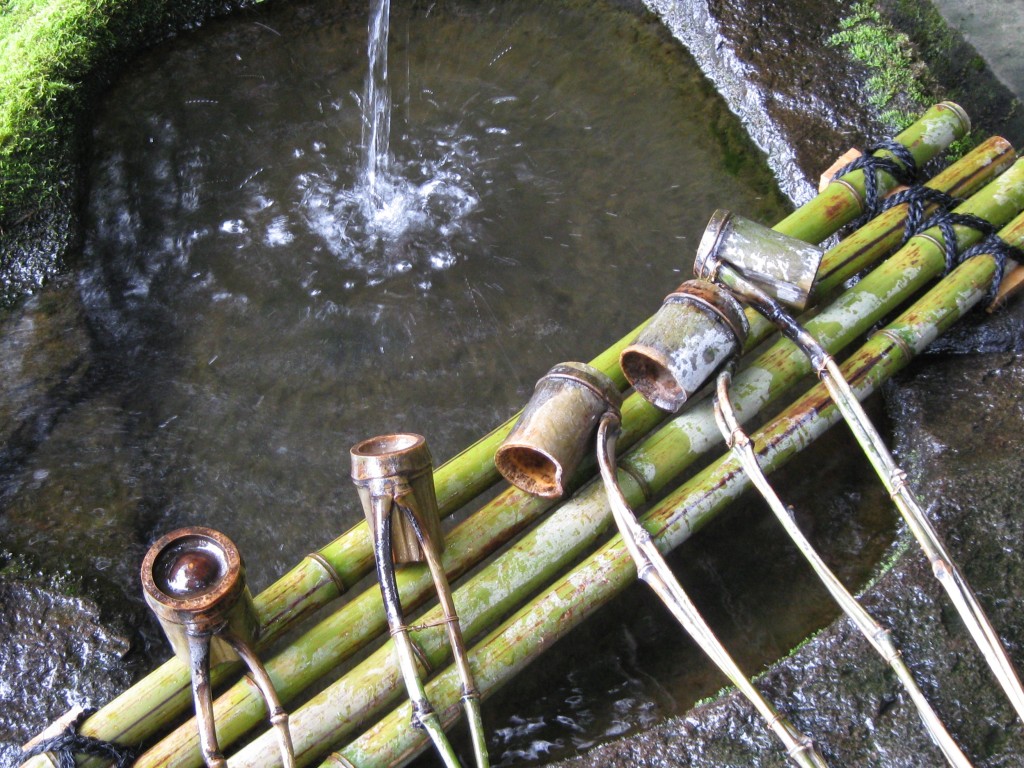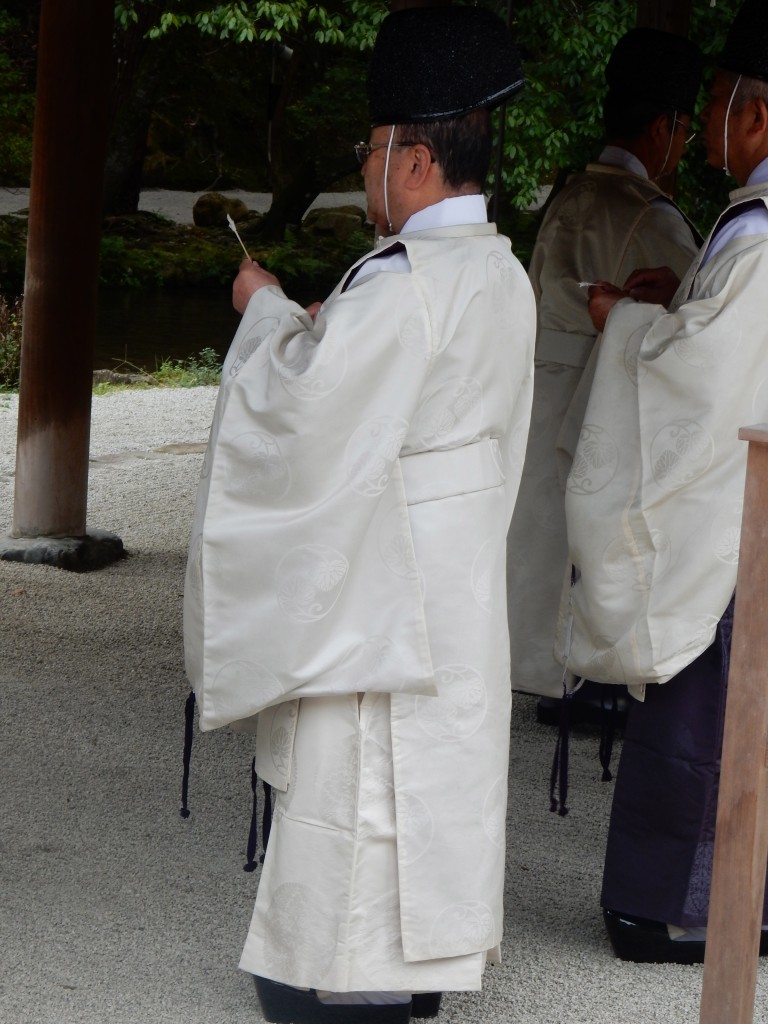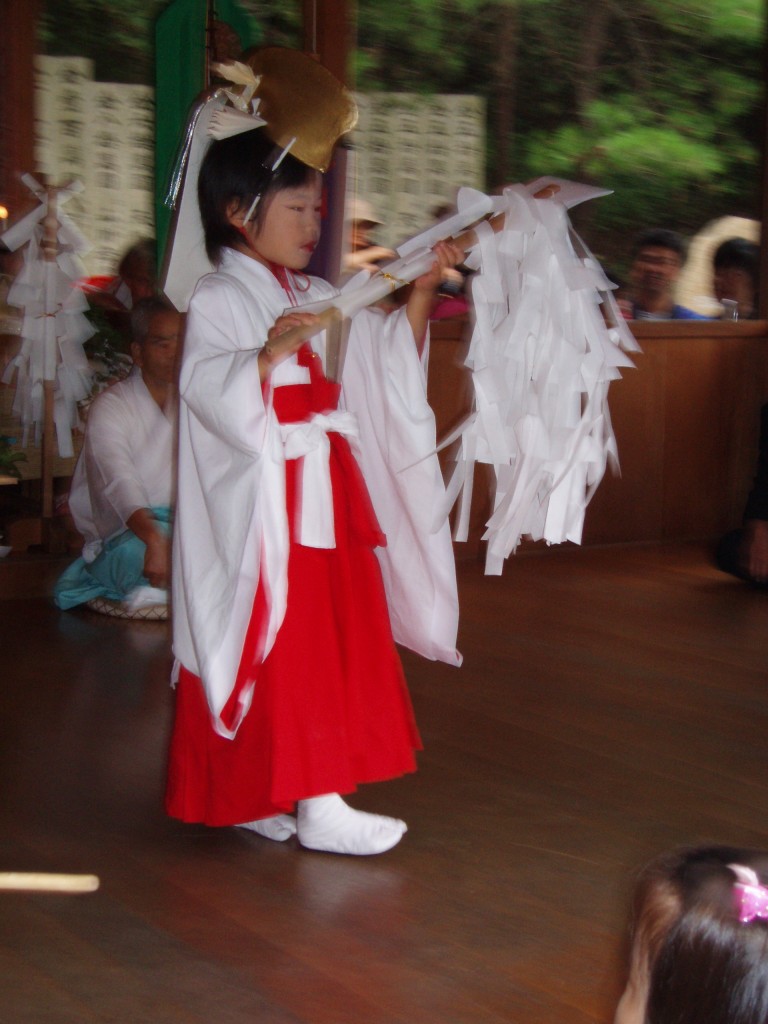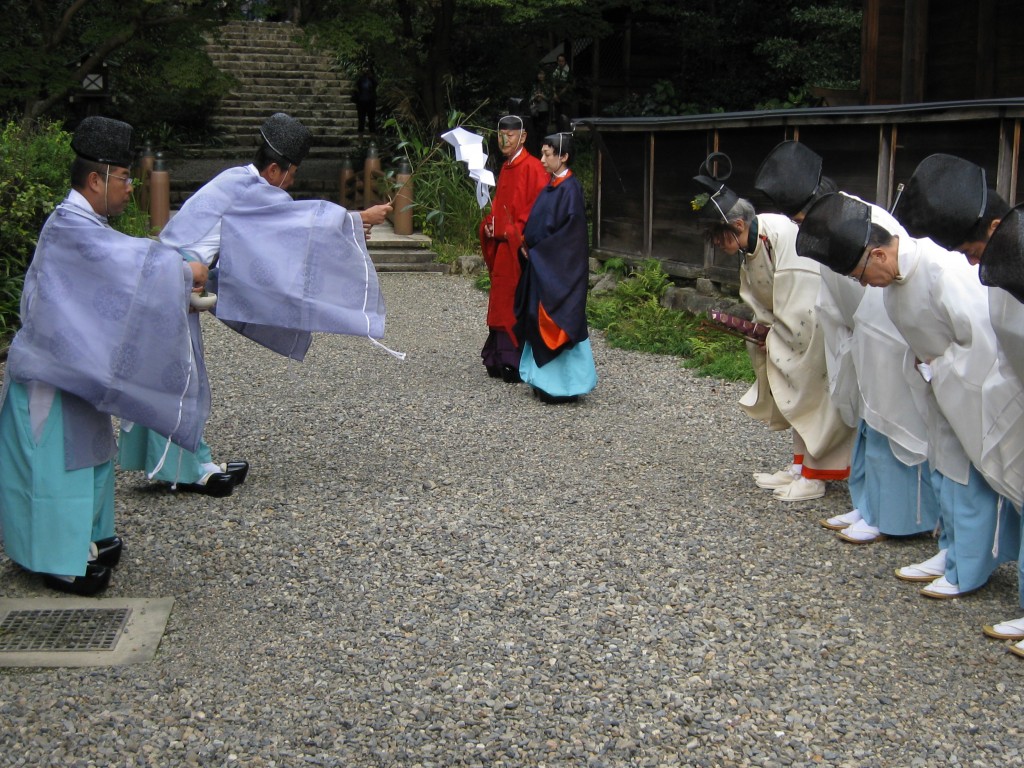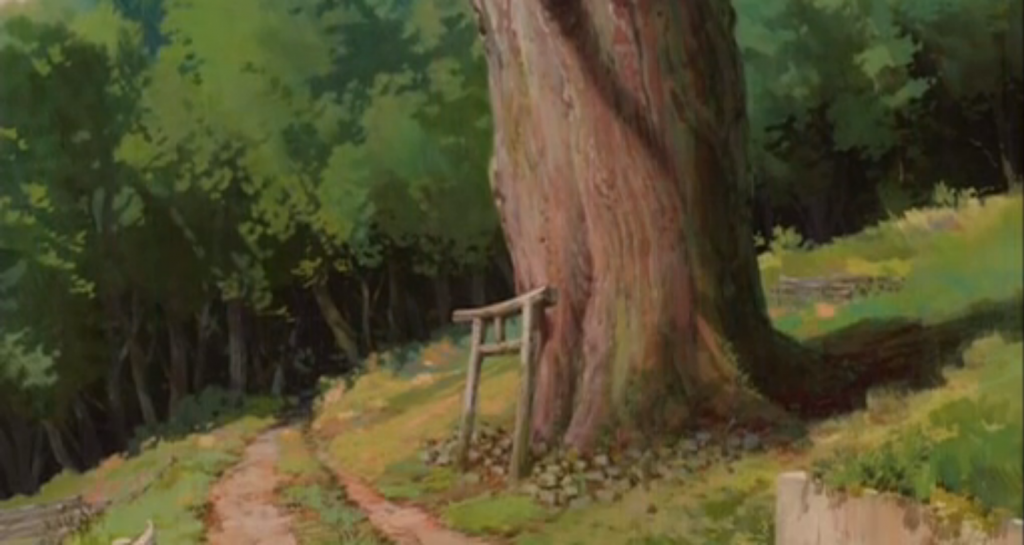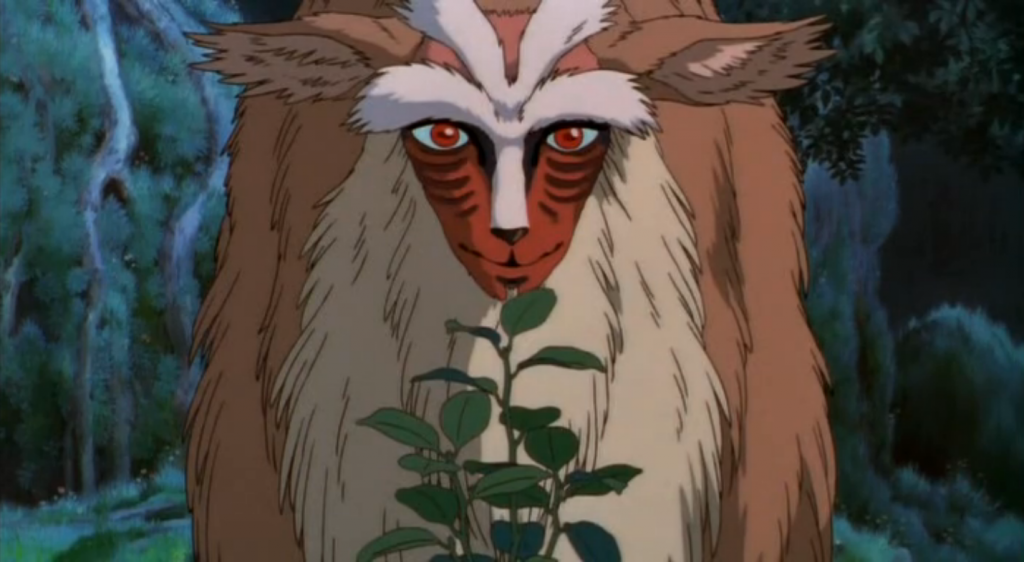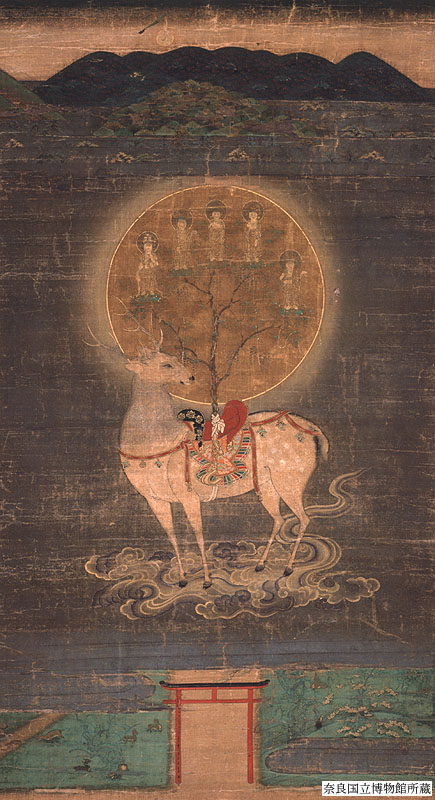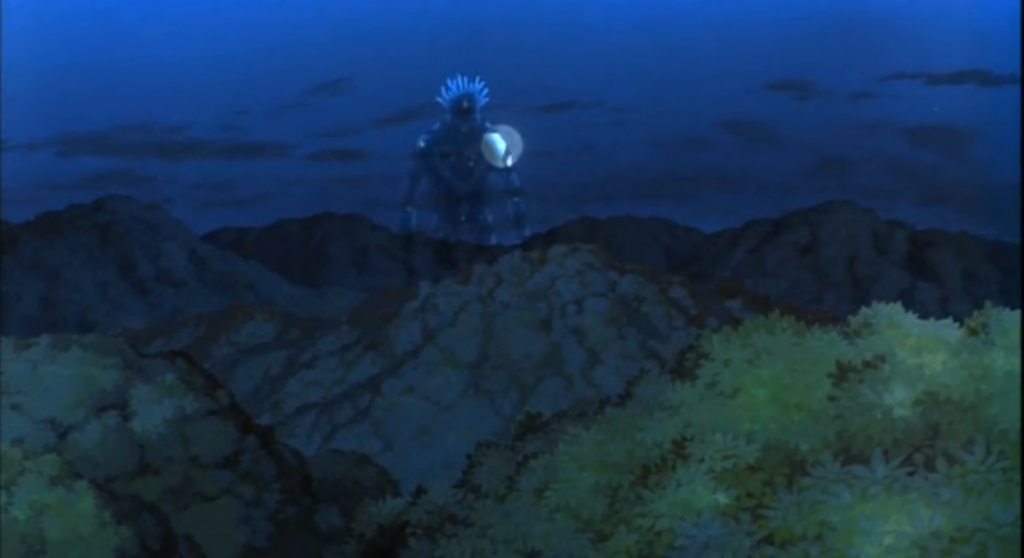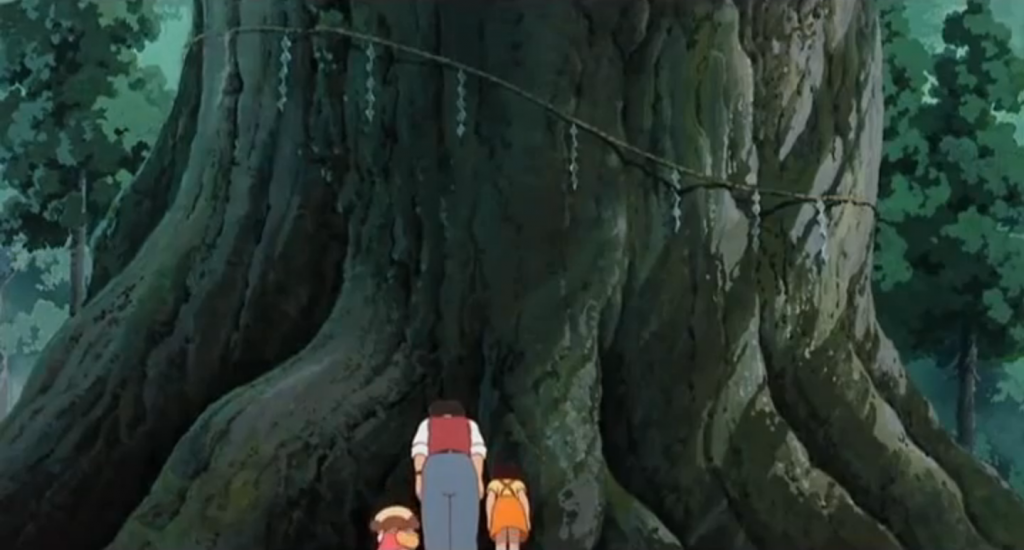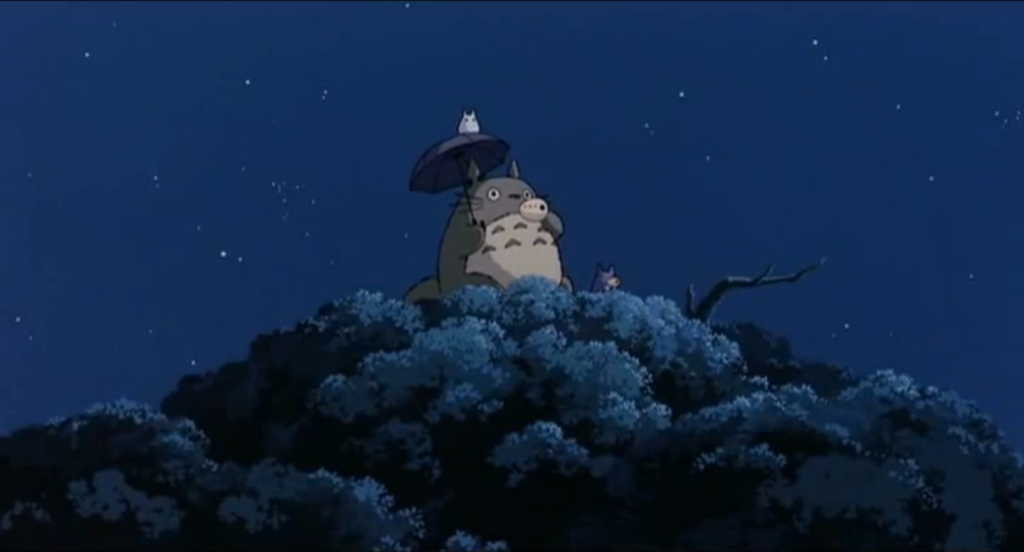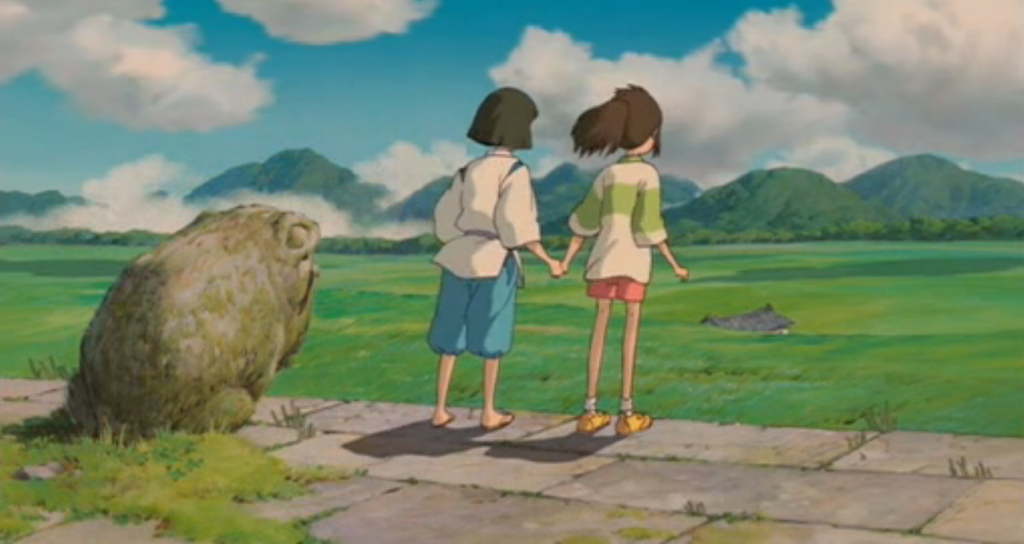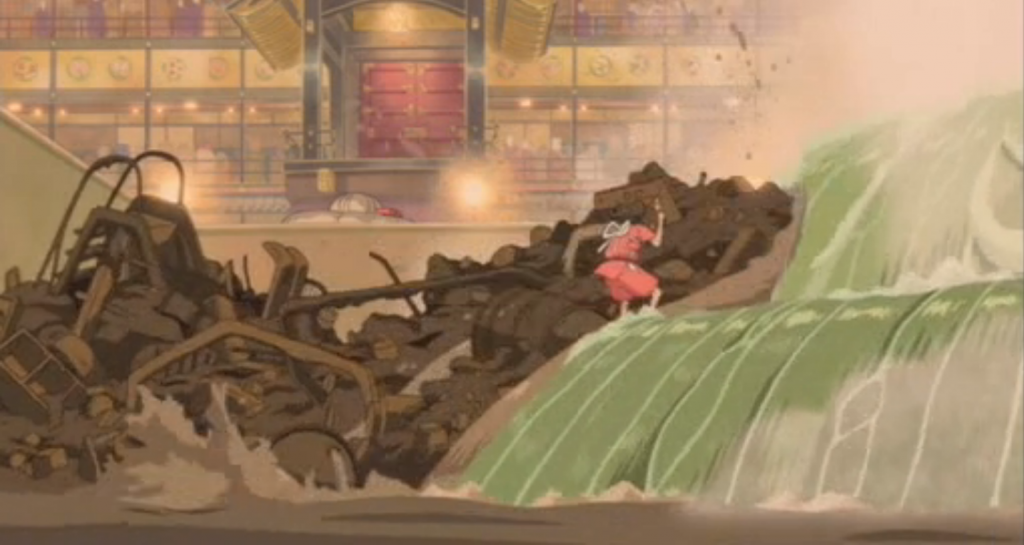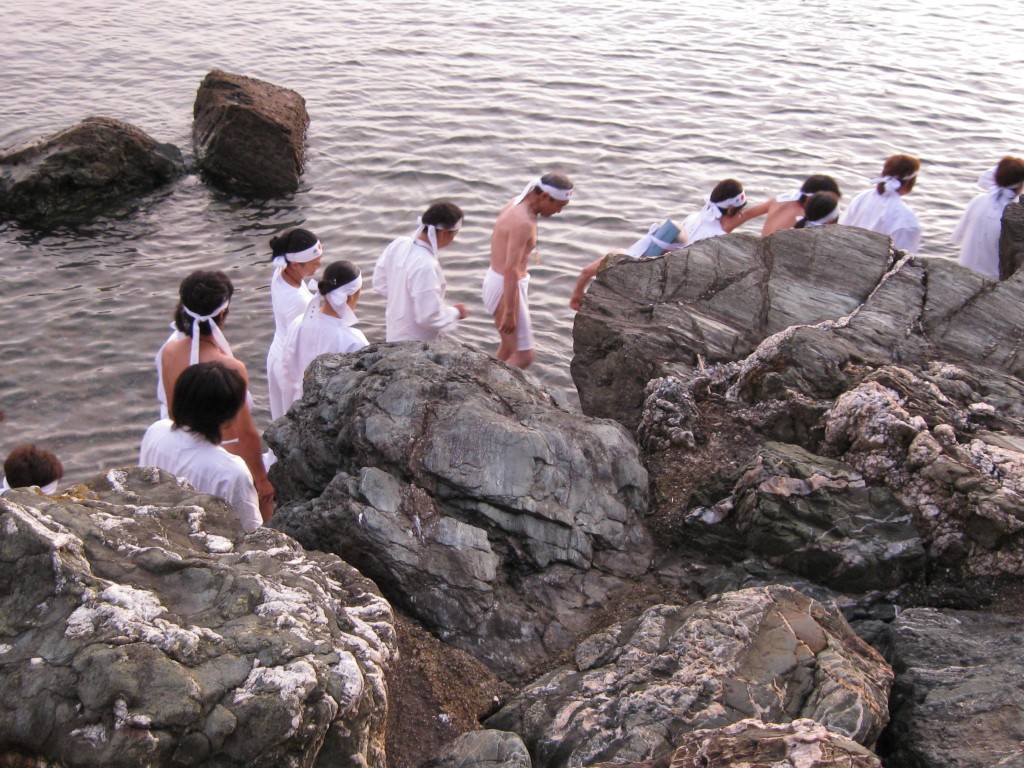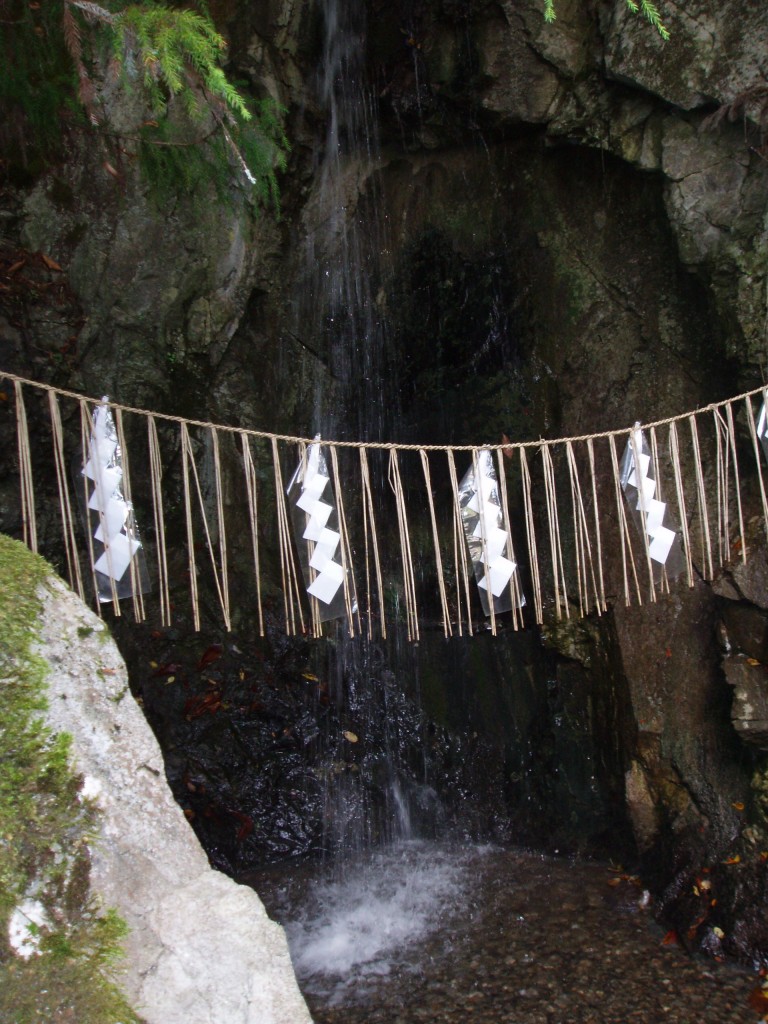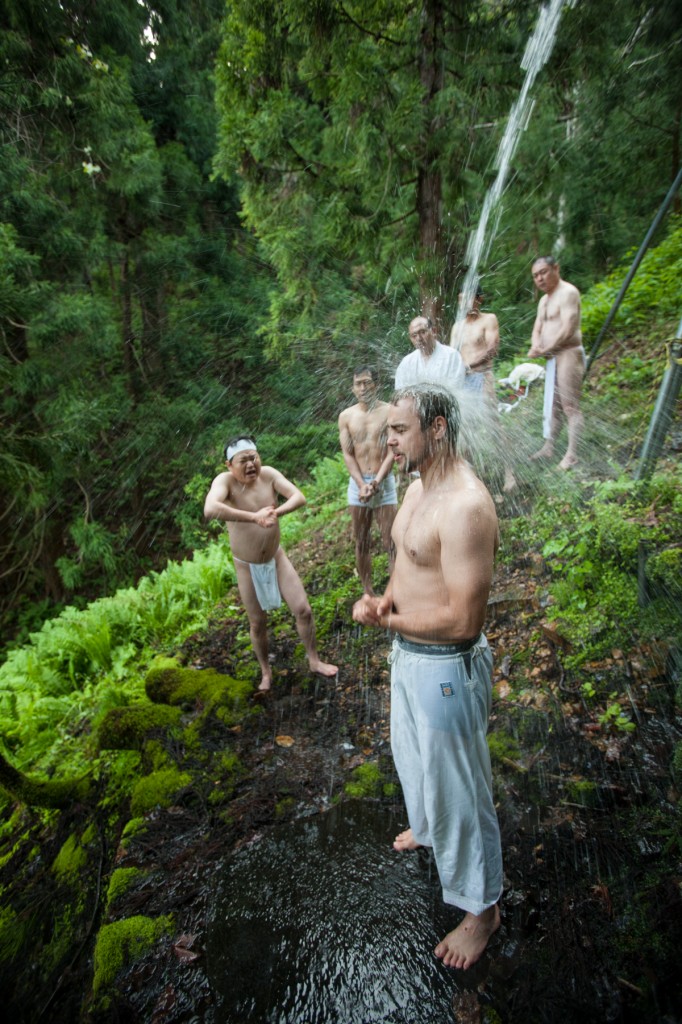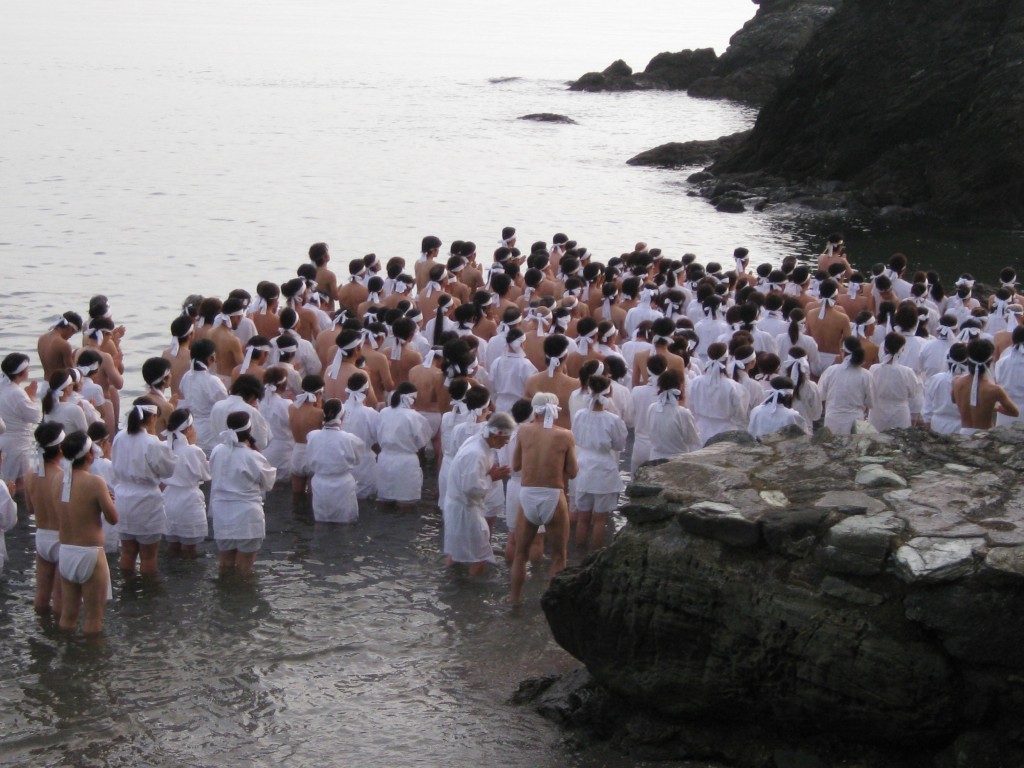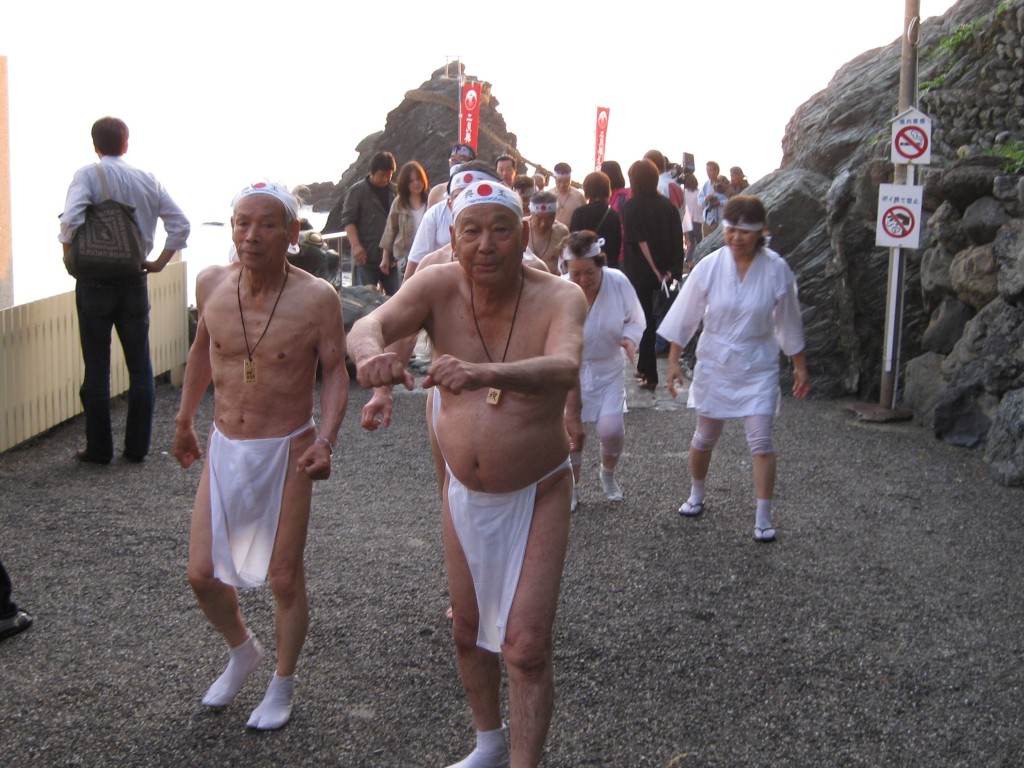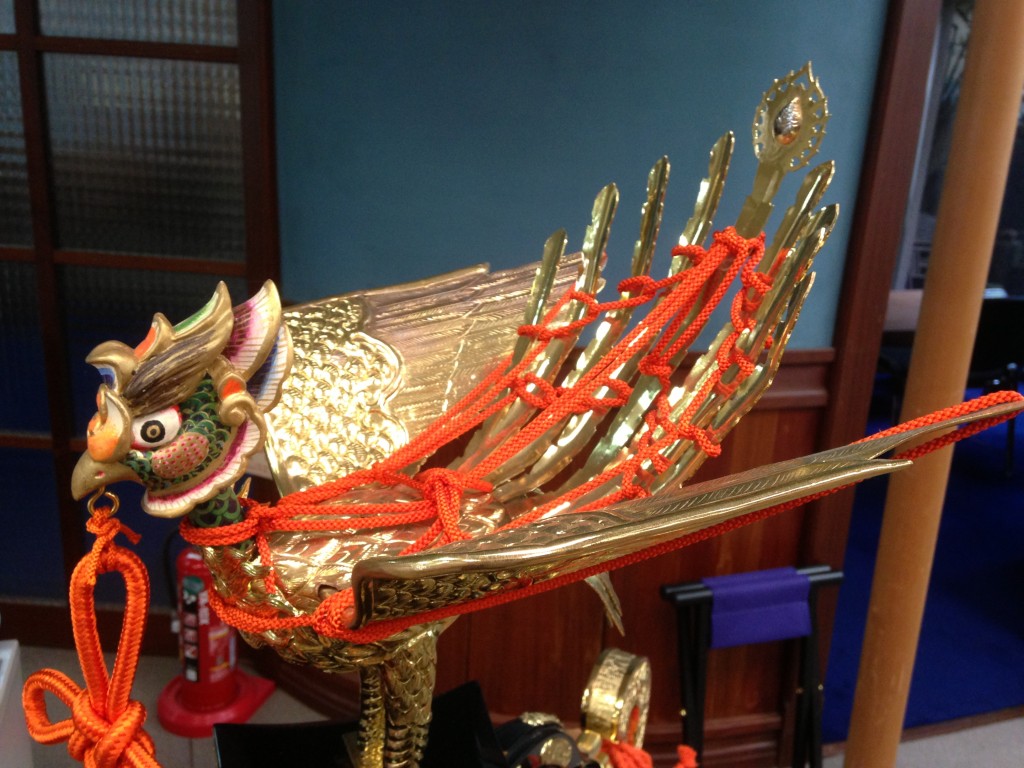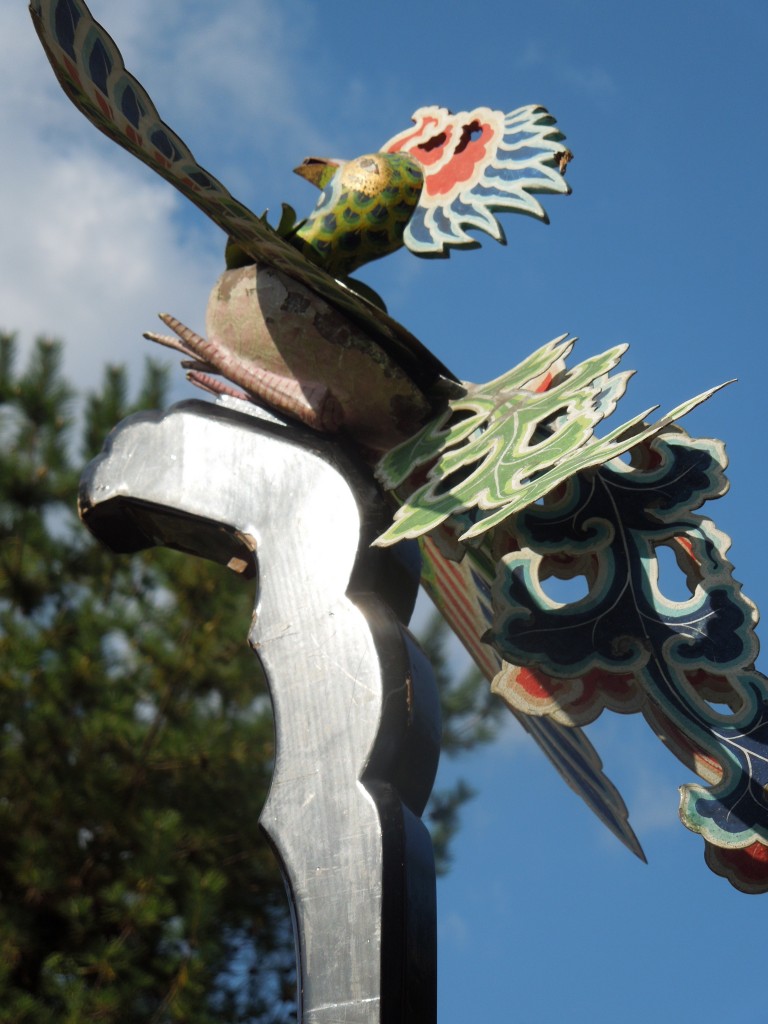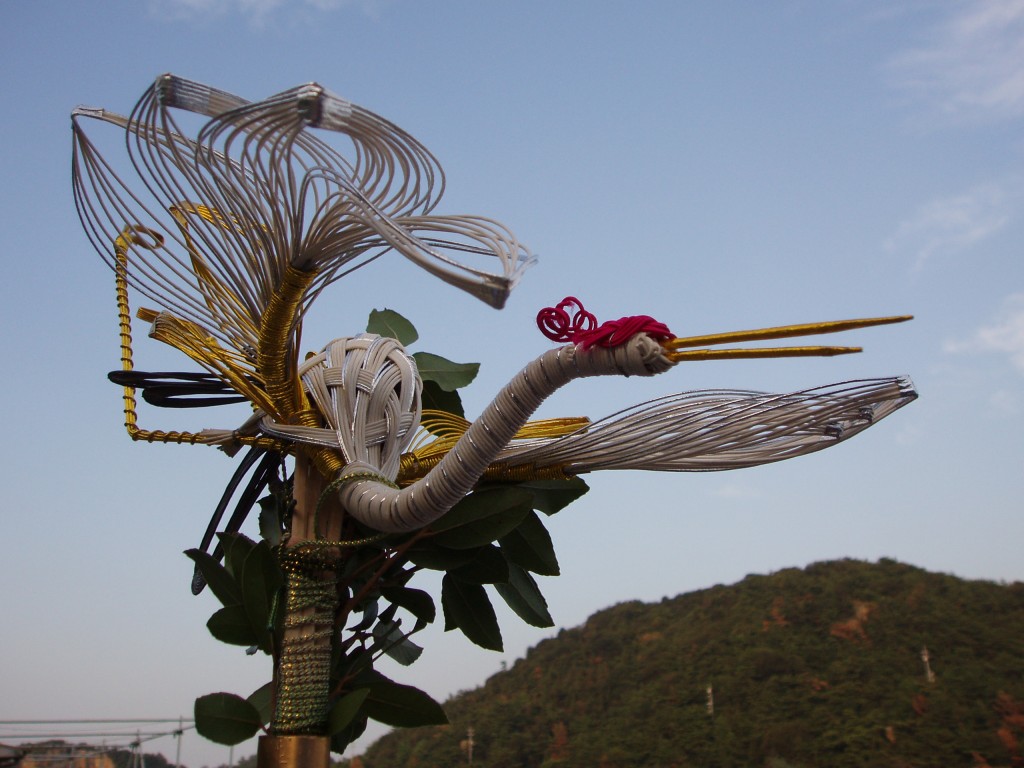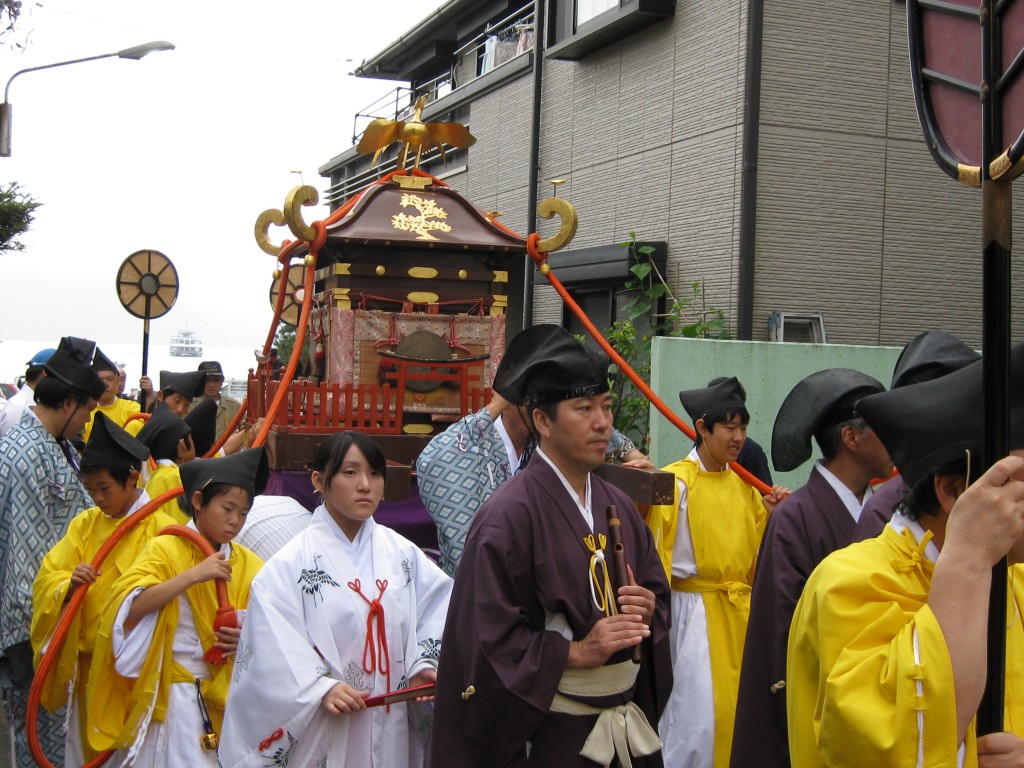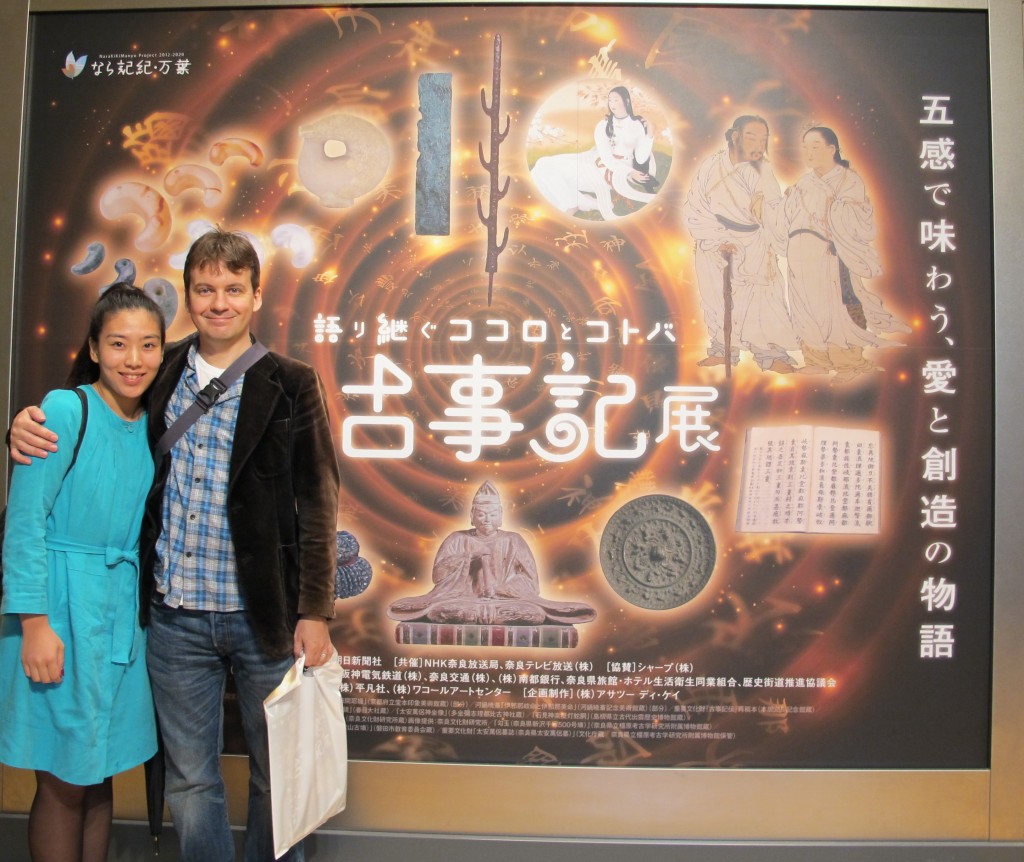
Michael Lambe and fiancée Miu, eager visitors to the Kojiki exhibition currently showing at the Nara Prefectural Museum
Green Shinto is delighted to host a piece by Deep Kyoto blogger, Michael Lambe, about the current major exhibition at the Nara Prefectural Museum of Art. (The exhibition is on until December 14th.) To learn more about Michael’s blog, please see (http://www.deepkyoto.com/). All photos provided by Michael Lambe (artwork from unknown sources).
********************************************************
The Grand Kojiki Exhibition at Nara Prefectural Museum of Art
by Michael Lambe
On a cold, wet Sunday in early November, my fiancée Miu and I went down to Nara and took in the Kojiki exhibition now on at Nara Prefectural Museum of Art. The rain was coming down in sheets when we arrived, so it was perfect museum weather!
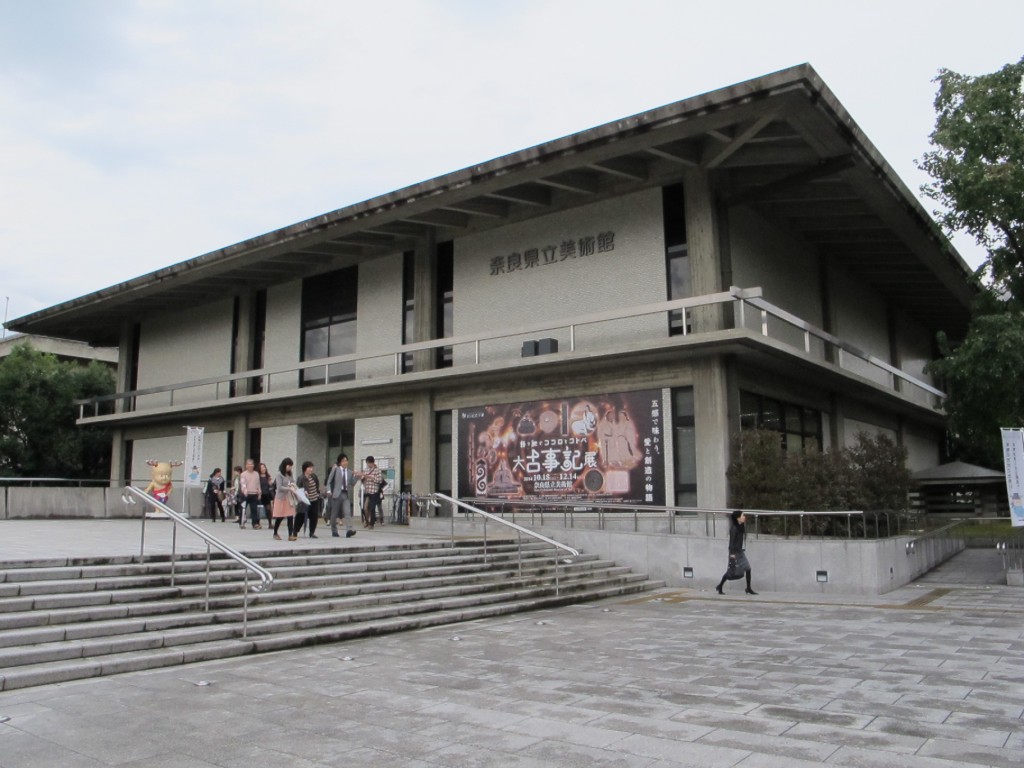
Nara Prefectural Museum of Art, not far from the Deer Park
The Kojiki or Record of Ancient Matters is a collection of myths detailing the creation of the Japanese archipelago, along with stories of the first Gods, heroes and emperors. Compiled in 712 it is the oldest book in Japanese. It is also notoriously difficult to read, even in translation. The exhibition’s own stated aim is to overcome this difficulty and help the visitor to look beyond the text’s ancient language and obscure cosmological convictions, to the lives and emotions of the people from whose culture these legends sprang. To do this they have gathered art and archaeological materials from city museums and private locations across Japan that provide a thoroughly immersive Kojiki experience. The result is a comprehensive overview of this book’s place in Japan’s cultural history. We spent a good afternoon at the exhibition learning that the text of the Kojiki, and its mythological contents, have been not only a rich source of creative inspiration, but also historically of propaganda and political influence. In both regards it is a fascinating story!
The exhibition is divided into six parts and these are as follows:
Prologue – Statues of the early Gods
I. The Story Woven by Ancient People – Art works depicting Kojiki tales.
II. 1300 Year Old Kojiki – The history of the book.
III. Items Illustrated in Kojiki – Archaeological artifacts and replicas.
IV. Kojiki Still Alive Today – Shrine treasures and traditions associated with the Kojiki.
V. The Story to Pass on to the Future – Modern art works inspired by the Kojiki.
Of these the Parts I and II struck me as being of most interest, so that is where I shall focus most of my attention.
Prologue
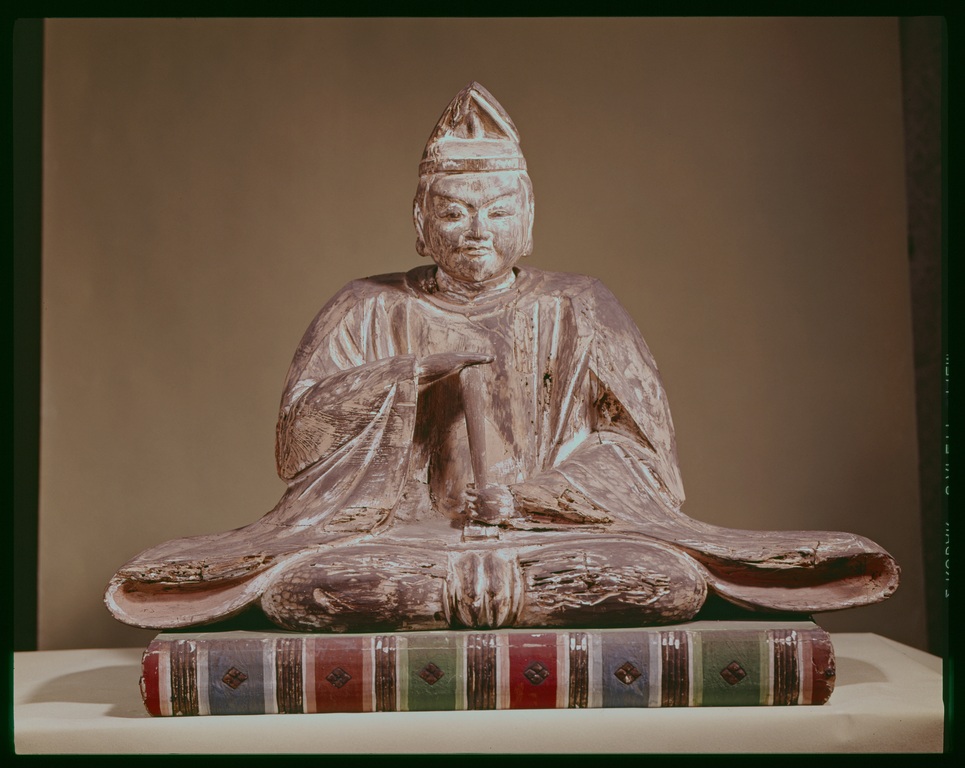
O-no-Yasumaro, compiler of the Kojiki
A short section this, but it sets the mood. First we encounter a Muromachi era statue of Ō-no-Yasumaro the compiler of the book. The historical Ō-no-Yasumaro had the unenviable task of weaving several competing clan narratives and traditions into one coherent text that would support the rule of the dominant imperial line. His face as depicted is unusually detailed for a sculpture of that era and it has an appropriately determined look about it.
In the room beyond the compiler we encounter the Gods. A light projection of the text scrolls around the walls, and among various deities we find simple wooden Heian era statues of the first creator Gods: Izanagi-no-Mikoto (the principal male deity) and Izanami-no-Mikoto (the principal female). These are the gods, who with the aid of a heavenly jeweled spear, stirred creation out of primary chaos. Wonderfully preserved, the statues are seated and gaze at us impassively across a thousand years.
Part I. The Story Woven by Ancient People
Part I is more colourful. Essentially it is a gathering of art works inspired by some of the key episodes and stories depicted in the Kojiki: of how the Gods made the world and then their descendant emperors carved out a nation. This collection is further sub-divided by three themes:
1. Initiation
2. Journey
3. Affection
The first section, Initiation, explores the beginnings of the Japanese mythological cycle, and also the interweaving of legend and ancient ritual. One of the key tales illustrated in this section is that of the sun goddess, Amaterasu Ōmikami and the heavenly rock cave. Terrified by the violent rages of her brother, Susanoo-no-Mikoto, the god of wind and storms, Amaterasu hid herself away in Ama-no-Iwato, the heavenly rock cave, thus depriving the world of light.
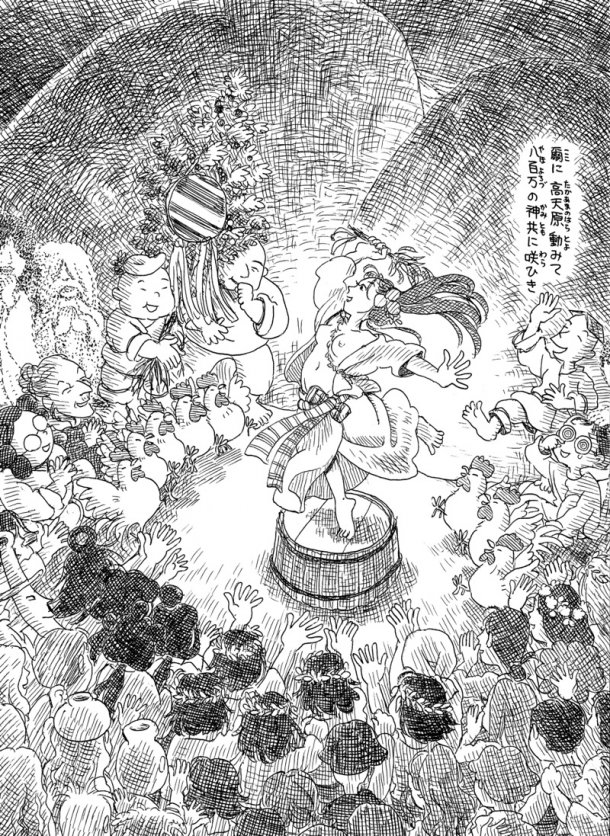
Uzume's dance, as depicted in 'Ball Pen Kojiki'
Plunged into unending night, a myriad deities gathered at the rock cave, and hoping to conjure the sun back into the world they gathered many items of ritual significance, among them a bronze mirror, magatama beads, and branches of sakaki. As if to encourage the dawn, cocks were made to crow at the cave entrance. But finally it was the goddess of dance, Uzume, whose lewd striptease brought Amaterasu back out.
Dancing wildly and exposing her breasts and genitalia to the assembled deities, Uzume made them laugh so much, that Amaterasu wondered at their hilarity. Unable to restrain her curiosity she peeped out from her shelter. Immediately, Tajikawaro, a deity of immense strength, pulled the sun goddess out and with a great rock blocked the entrance behind her. The sun and light were restored to the world and all the deities rejoiced.
In Uzume’s dance we can perhaps see an echo of ancient rites that associated dance and fertility with the return of light and heat both with the dawn and with spring. The primal energy of the dance is very well represented by a manga style drawing we will see later in the exhibition, by Kōno Fumiyo.
The work that dominates this section though, is a massive Italian style fresco by Kinutani Kōji. Amaterasu, who as sun goddess, is first among the gods in heaven, is also according to myth, the direct ancestor of the Japanese Imperial line. Here she is depicted emerging from the rock cave in a radiant surge of primary colours. On her person she already bears the three imperial regalia of mirror, sword and magatama beads, but her face is lit by a warm and gentle smile.
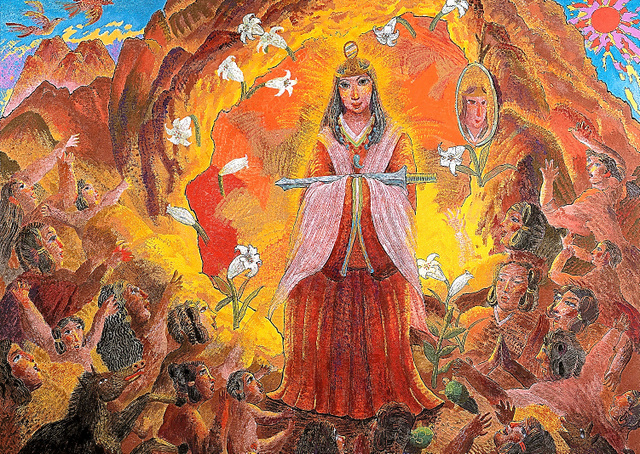
Ama-no-Iwato, At the Dawn by Kinutani Koji, 2012
In the following sections Journey and Affection, we learn to view travel and love through the lens of an ancient world view. Travel in the Kojiki is never undertaken lightly but always for a serious and specific purpose. And in a world strictly divided by gender roles, only men travel. Women are encountered on the way and offer assistance to the wandering gods and heroes. Sometimes the protagonists will fall in love, but again love in the Kojiki, is something wild and free and beset by doubt, jealousy and betrayal.
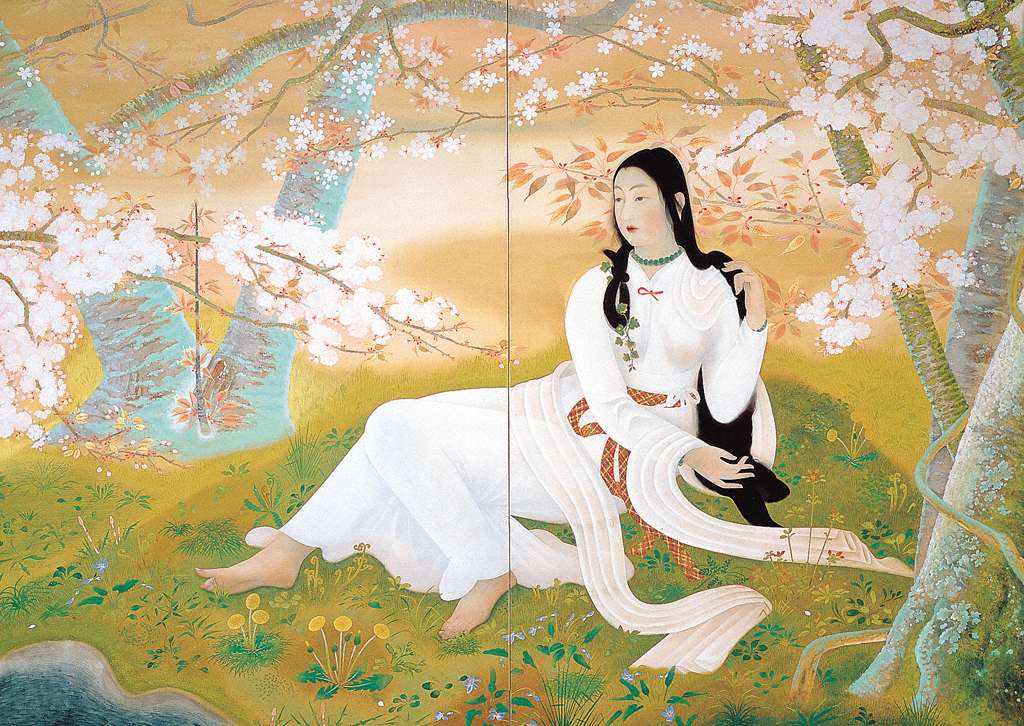
Konohanasakuya-hime by Domoto Insho, 1929
Another giant mural by Kinutani Kōji introduces us to the character of Ninigi-no-Mikoto, grandson of Amaterasu, as he descends to earth to teach the world the art of rice-planting. We are told he arrived on a beach in Kyushu and there met and fell in love with the blossom princess, Konohanasakuya-hime. Dōmoto Inshō’s nihon-ga depiction of the flower princess surrounded by cherry blossoms is one of the loveliest paintings in the exhibition. She seems to represent an ideal of Japanese feminine beauty
We are told that Konohana’s father, a mountain deity, wished for Ninigi to marry his other daughter Iwa-naga, a rock princess. Ninigi, however, had his heart set on Konohana, and refused the other daughter… and so now human lives pass swiftly like the cherry blossom and do not endure like rock. The union of Konohana the flower princess and a male from the lineage of the sun also has another more political significance, for their descendant Jimmu, will be the first emperor of the Yamato clan.
Meanwhile, however, Susanoo-no-Mikoto, storm god of mayhem and mischief, having being exiled from heaven for his crimes against Amaterasu, is busy establishing his own rival lineage.
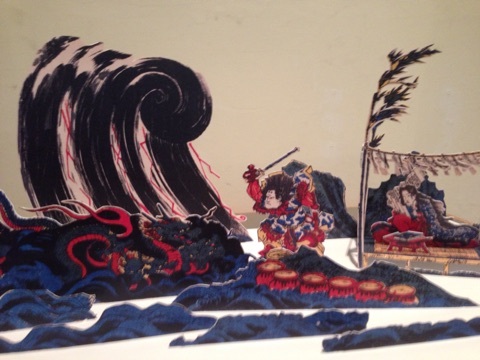
Yamata-no-orochi-Taiji: a three dimensional cut-out print of Susanoo slaying the eight-headed serpent by Utagawa Toyohisa, Edo Period
Descending to earth in Izumo province Susanoo encountered an old couple weeping bitterly. They told him that an eight-headed serpent had come each year for seven years to devour seven of their daughters, and now only their eighth daughter was left. Susanoo offered to save the daughter in return for her hand in marriage, and the old couple readily agreed. The storm god then defeated the monster with his characteristic combination of ferocity and cunning. Having tricked the beast into a drunken stupor by preparing eight barrels of saké, he proceeded to cut it to pieces. Susanoo then married the eighth daughter and established his own Izumo clan lineage. What is curious about this story is Susanoo’s own sudden transformation from a rebellious troublemaker into a hero overcoming the forces of chaos. This seeming contradiction in his character may well reflect the fact that the Kojiki was compiled from many sources and clan traditions. Perhaps here we can see the rival legends of the Izumo clan being forced to play a part in a wider narrative written to serve the imperial Yamato line.
Part II. 1300 Year Old Kojiki
In Part II of the exhibition we explore the history of the text itself. The Kojiki is of course an invaluable record of early Japanese folklore, tradition and spiritual belief and as we have seen in the previous section a great source of creative inspiration. However, it is also a political text with a long and complex relationship with this nation’s historical sense of itself. A timeline on one wall supported by examples and replicas of books from various eras gives a good overview of the Kojiki’s checkered past. In 712 when the book was complied, its primary purpose was to justify the rule of the dominant imperial lineage. It subsequently fell out of favour in the Heian era, and for a long time the Nihon Shoki was more popular. However when the Nativist scholar Motoori Norinaga raised the Kojiki back out of obscurity in the 18th century, it was again for political purposes, in support of a nationalist and imperialist agenda.
The ideology espoused by Norinaga encouraged the Restorationists of the 19th century, and from the Meiji era onwards the Kojiki was used as a propaganda tool in state sponsored Shinto. As a result, this book, Japan’s oldest, came to be deeply associated with the militarism that ultimately led to the catastrophe of World War 2. Naturally it then fell out of favour again in post-war years, but since the 1300 year anniversary of the book’s completion in 2012 it has again been enjoying a boom in popularity. It is still important though to approach this book with care, and with an awareness that though there is much of value contained within its pages, the history of the book itself is one fraught with controversy. I am happy to say that the exhibition in Nara does not shy away from exploring this.
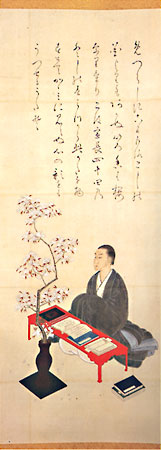
Self portrait by Motoori Norinaga in 1773
In this history of the book, 18th century scholar Motoori Norinaga plays a central role for without his championing of the Kojiki we would probably not be discussing it today. However, his motivations were decidedly problematic. Norinaga sought to promote the superiority of Japanese culture by raising the significance of the native Shinto religion and for his purposes the myths of the Kojiki were of vital importance. Unfortunately like many ardent nationalists, Norinaga felt a deep loathing for foreign cultures particularly Chinese culture. A poem he wrote to accompany his self-portrait at the age of 44 exemplifies this attitude.
Norinaga wrote,
「めつらしきこまもろこしの花よりもあかぬいろ香は桜なりけり」
More than any rare or foreign flower, it is after all only cherry blossom that never tires me.
This tying of Shinto beliefs and Kojiki tales to a nationalist and anti-foreign agenda was pernicious. Viewing the picture above and also 19th century children’s editions of the Kojiki, which were specially abridged to indoctrinate youth with love of country and martial pride, I could not help think of modern day nationalists like Shinzo Abe. Similarly they preach love of country and call for a strong military with a reckless inattention to the darker lessons of history.
I was pleased though by a video display here, a 3D animation revealing both the similarities and differences between myths around the world. Before a rapt audience, golden representations of Izanagi and Izanami appeared and faded into Adam and Eve, and Susanoo and the eight headed serpent faded into Perseus and Medusa… Despite the efforts of those in the past to use these myths as a bulwark against foreign influences, the organizers of this exhibition had both acknowledged those mistakes and sought to make connections.
Part III. Items Illustrated in Kojiki
In Part III we step deeper into the ancient past with archaeological finds and replicas that help us better imagine and understand the culture that created the Kojiki. Here are many items we might see described in the Kojiki: weapons, accessories, vessels, and musical instruments. Pre-eminent are the three traditional ritual regalia of the Yamato emperors: the mirror, sword and magatama beads that Ninigi-no-Mikoto received from Amaterasu Ōmikami when he descended to earth. I was particularly impressed by a shining 6th century sword from the Kofun period in remarkably good condition. 5th century Haniwa clay representations of a house and of a boy playing a harp were also fascinating.
Parts IV and V – The Kojiki Today
The rest of the exhibition shows how the Kojiki is still very much a part of modern Japanese culture both in its pop and traditional incarnations. Manga comics, like Kōno Fumiyo’s Ball Pen Kojiki, do an excellent job of expressing the motion and energy of the original tales. And the sacred dance of Uzume has a living continuity in the traditional dances of Kagura and Noh theater. Looking at the Noh and Kagura masks on display is indeed an encounter with the gods.
A final section is devoted to three very modern artworks commissioned especially for this occasion. In Game Center Amaterasu for example participants must dance in step with Uzume to lure the sun goddess from her heavenly rock. I confess I was largely unimpressed by these final works, but one thing did amuse me. One of the commissioned artists had littered the floor with globes representing the Earth which rolled around emitting mysterious voices. A little boy of about 9 years old, thoroughly dissatisfied with the entertainment on offer, decided to kick them like footballs with increasing savagery until one of the globes fell apart. I couldn’t help laughing. After all it seems, the rebellious and irreverent spirit of Susanoo is alive and well!
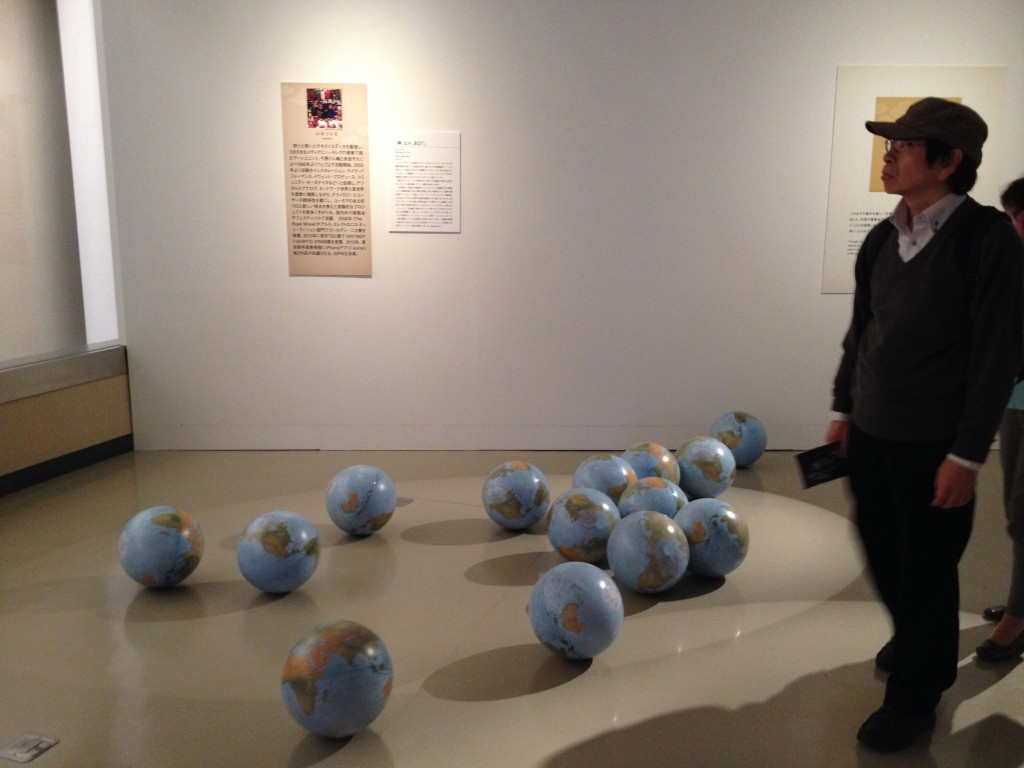
Those unfortunate globes
*******************************************************************************
The Grand Kojiki Exhibition at Nara Prefectural Museum of Art continues until December 14th 2014. Entry is free for foreigners who are carrying some form of identification. There is also a very reasonably priced book, which catalogues pictures of all the exhibits, available in the museum shop.
Though some of the information at the exhibition is given in English, the bulk of it is not, so some familiarity with the stories of the Kojiki is definitely an advantage. And if you are not confident about your Japanese language ability, then having a Japanese friend to help you is also a good idea. I was certainly glad that my fiancée, Miu was with me to guide me through the ancient cosmology.
More details in Japanese and a map to the Museum are here: http://www.pref.nara.jp/miryoku/daikojikiten/
*********************************************************************************
Michael Lambe is the author of the Deep Kyoto blog (http://www.deepkyoto.com/) and Chief Editor of the Deep Kyoto: Walks anthology available from Amazon: http://www.amazon.com/dp/B00KFM2J0C\
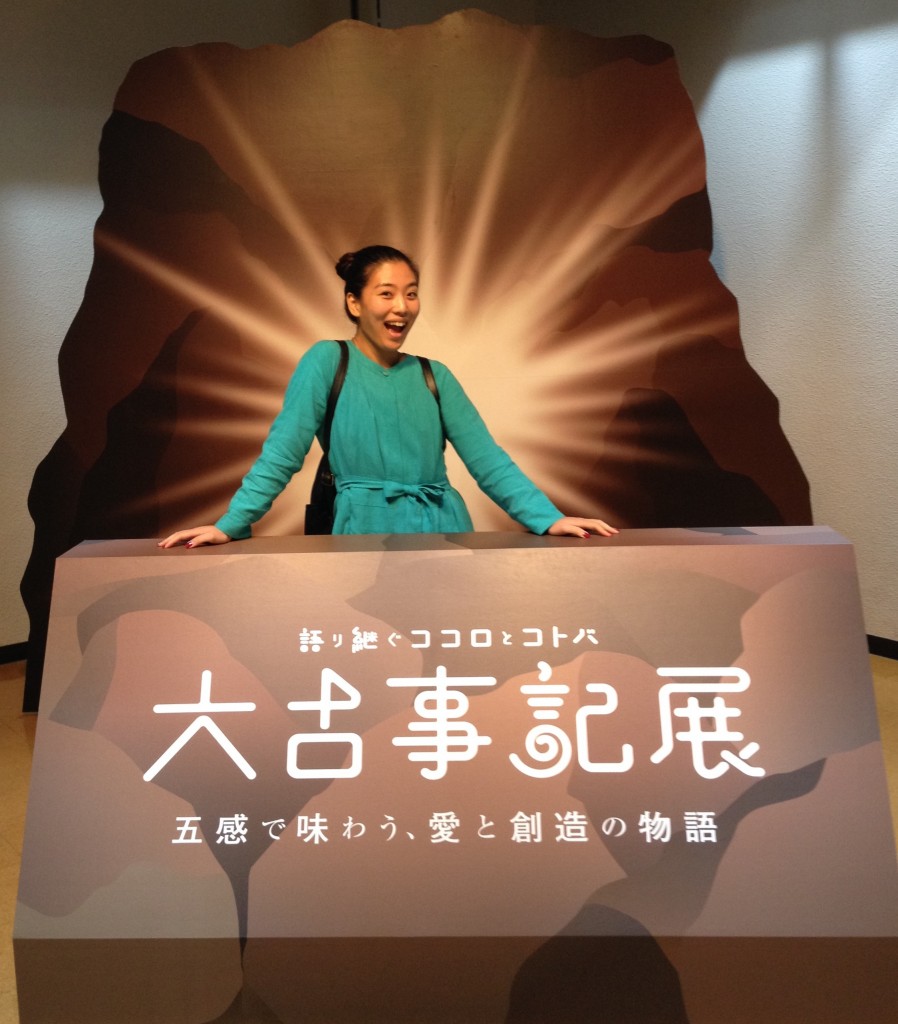
Miu emerges radiant from the heavenly rock cave
